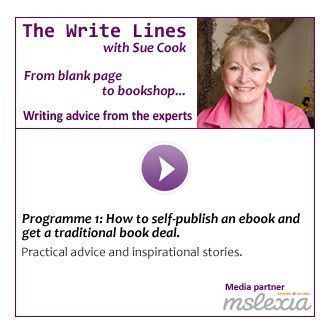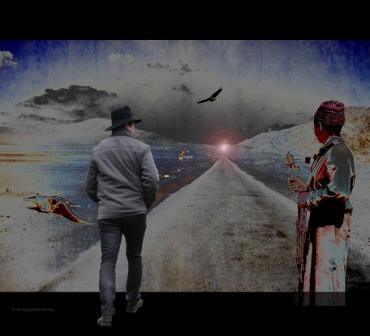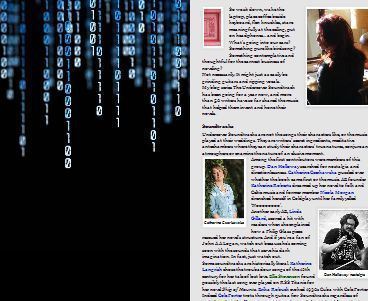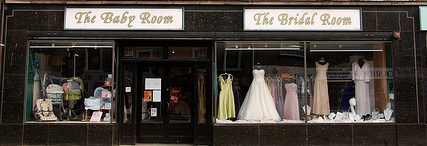Roz Morris's Blog, page 90
October 31, 2012
‘Music to wake the living’ – The Undercover Soundtrack, Consuelo Roland
 This week, Undercover Soundtrack day falls on Halloween – shiveringly close to Mexico’s El dia de los Muertos. And my guest has more than risen to the occasion with her award-winning literary novel The Good Cemetery Guide. It centres on a guitar-playing mortician’s son and she built his life and loved ones from reggae, Texan ballads, traditional Mexican music, Phil Collins and Robbie Williams. You’ll grin like a ghoul when you see what she took from Meatloaf. She is essayist, poet and novelist Consuelo Roland and she’s on the Red Blog, sharing her Undercover Soundtrack.
This week, Undercover Soundtrack day falls on Halloween – shiveringly close to Mexico’s El dia de los Muertos. And my guest has more than risen to the occasion with her award-winning literary novel The Good Cemetery Guide. It centres on a guitar-playing mortician’s son and she built his life and loved ones from reggae, Texan ballads, traditional Mexican music, Phil Collins and Robbie Williams. You’ll grin like a ghoul when you see what she took from Meatloaf. She is essayist, poet and novelist Consuelo Roland and she’s on the Red Blog, sharing her Undercover Soundtrack.


October 29, 2012
How to self-publish an ebook and get a traditional book deal – guest spot on The Write Lines podcast
 When I was first discovering blogs – and looking for a home for my own fiction – I discovered The Write Lines on BBC Radio Oxford. Presenter and novelist Sue Cook brought together experts from UK publishing to give advice, information and resources for new writers.
When I was first discovering blogs – and looking for a home for my own fiction – I discovered The Write Lines on BBC Radio Oxford. Presenter and novelist Sue Cook brought together experts from UK publishing to give advice, information and resources for new writers.
Fast forward through a few revolutions and the latest series (now a podcast) is exploring indie publishing – both as a leg-up to a traditional deal and a viable option in itself. Some of the authors whose blogs I was reading as the first series aired are her experts this time – including Nicola Morgan and Catherine Ryan Howard – and me. I feel like I’ve graduated. Exciting times…
In my episode I’m sharing a studio with indie superstars Mark Edwards (one half of the Edwards/Louise Voss partnership) and Mel Sherratt. You can either listen on the site or download….


October 28, 2012
If you write what you know, where do you get ideas?
 What does this phrase mean, ‘write what you know’? New writers are often baffled by it, and feel their creativity has been stomped on. Most of us have a regular life with average troubles and jobs that aren’t the stuff of stories. And we want to write fiction to escape, explore, expand – so how do we do it?
What does this phrase mean, ‘write what you know’? New writers are often baffled by it, and feel their creativity has been stomped on. Most of us have a regular life with average troubles and jobs that aren’t the stuff of stories. And we want to write fiction to escape, explore, expand – so how do we do it?
Find your people in fiction
Great stories come from great characters. We might know a few people in real life with traits that are good story fodder, but not suitable wholesale. Most writers get inspired by characters they meet on the page – and especially in fiction.
In the UK at the moment there’s a scandal about an eccentric disc jockey and charity worker. He died a year ago and now we’re stunned to hear he’s accused of indecent acts. An often heard remark is ‘how could someone who did such immense good also do such evil’? Read some literature, though, and you’ll know – very well – how it is possible for remarkable people to have extreme sides.
More than any other written medium, novels can give us a person stripped bare, scrutinised in three dimensions. We see how they behave with their friends, family, strangers, people they think will never see them again. We can peek at what goes through their heads when they’re on their own. That’s a level of honesty you don’t even get in historical texts or biography. And you certainly don’t get that access to the people you rub along with in real life.
Reading fiction gives you characters you’re curious to understand, and that can guide who you’re interested to write.
 Find your plots in your obsessions
Find your plots in your obsessions
Some novels are written about normal, domestic lives. But many more are about characters in danger, or on the edges of society, or realms of the extreme and extraordinary. Have all those writers had racy, perilous lives? Most have not; their natural habitat is usually a desk, like you and me. (Or if they have been adventurers, the chances are they don’t do the writing too.)
Ghostwriters, historical novelists, crime writers, fantasy and science fiction novelists are the living proof that you don’t have to have to write what you have personally experienced. But what these writers are good at is thorough research, led by genuine interest, so they can inhabit these environments as though they were real.
Write what you know – don’t let this stuffy phrase smother your imagination. Novels are not created by your daily life, but your inner life.
You’re interested in certain kinds of people? That’s who you ‘know’, on a writing level. You’re interested in certain kinds of story, settings or time periods? There’s what you know – or can know – well enough to write about.
Thanks for the pic H Koppdelaney
What feeds your writing and how different is it from your life? Are there other pieces of writing advice you’d like to take a hammer to? Share in the comments!


October 23, 2012
‘Music to depict lunatics in love’ – The Undercover Soundtrack, Ruby Barnes
 Murder ballads and psychological thrillers? Surely it was only a matter of time before a writer put themselves under the influence of Nick Cave. My guest this week used music as his portable aural office, banishing the sounds of his fellow rail passengers on his daily commute to immerse in shady characters. Sometimes he scared the real-world folks in the carriage too. He is Ruby Barnes and he’s on the Red Blog talking about his novel The Baptist and its Undercover Soundtrack.
Murder ballads and psychological thrillers? Surely it was only a matter of time before a writer put themselves under the influence of Nick Cave. My guest this week used music as his portable aural office, banishing the sounds of his fellow rail passengers on his daily commute to immerse in shady characters. Sometimes he scared the real-world folks in the carriage too. He is Ruby Barnes and he’s on the Red Blog talking about his novel The Baptist and its Undercover Soundtrack.


October 21, 2012
A site to help you fill the gaps in your story outline
 I’m shuffling ideas for The Venice Novel and I’ve come across a fantastic site that’s helping me clarify where I want to take the story.
I’m shuffling ideas for The Venice Novel and I’ve come across a fantastic site that’s helping me clarify where I want to take the story.
It’s called Television Tropes and Idioms. But don’t be fooled by its name. Tropes doesn’t mean cliches; it means story conventions and readers’ expectations. In fact, you can use the site as a cliche and stereotype warning – it tells you what’s already been done to death so you can keep your story and characters fresh and original. And the site includes movies and novels as well – of all types, all genres (and even stories that don’t fit easily anywhere).
I’m using it to fill gaps. At the moment I have a rudimentary cast of characters and a fundamental conflict, so I need to see what else could gather around it. Poking around in the subject sections (‘topical tropes’, in the left sidebar) suggested a lot more places I could take the characters and ways to develop the plot. It also gave me ideas for more defined roles my characters could play.
If you want to hit a particular genre, zip down the left-hand sidebar and look up ‘literature’ and you’ll find a list of categories to clarify where you fit. You can also check you’ve covered enough bases to satisfy readers and identify possibilities you might not have thought of.
But even if you don’t fit traditional pigeonholes (like certain folks I could mention), you can look up story ingredients, such as ‘war’, ‘betrayal’ or ‘family’ – just for instance, under the latter you get a delicious sub-list with suggestions like ‘amicably divorced’, ‘hippie parents’, ‘dysfunctional’.
Some writers get their first inspirational spark from a setting – if that’s you, you can research how other authors have done your setting justice, from pre-history to ‘4000 years from now (and no jetpack)’.
 One of the other things I like about it – very much – is its tone. No judgements are made about whether genres are fashionable, overworked, lowbrow or highbrow. It’s all about celebrating how stories work – or sometimes don’t. As we know, that comes down to the writer’s skill anyway, not whether a ‘subject’ is en vogue. And after a few hours in the company of their rather breezy descriptions, not only will you be better informed, you will be spurred to avoid the lazy story decision.
One of the other things I like about it – very much – is its tone. No judgements are made about whether genres are fashionable, overworked, lowbrow or highbrow. It’s all about celebrating how stories work – or sometimes don’t. As we know, that comes down to the writer’s skill anyway, not whether a ‘subject’ is en vogue. And after a few hours in the company of their rather breezy descriptions, not only will you be better informed, you will be spurred to avoid the lazy story decision.
If you’re sprucing up your outline – especially as NaNoWriMo looms – spend an afternoon exploring Television Tropes and give your story a thorough workout.
Do have any go-to sites when you’re planning a novel – and how do you use them? Share in the comments!
You can find tips for researching, outlining and what makes a robust story in my book, Nail Your Novel – Why Writers Abandon Books and How You Can Draft, Fix and Finish With Confidence. Available on Kindle and in print. You also might like my multimedia course with Joanna Penn – more than 4 hours of audio and slides with an 86-page transcription – find it here.


October 20, 2012
Music that changed my book – post at Authors Electric
 More than 50 writers have now contributed to The Undercover Soundtrack and plenty more are on the way. Today it’s my turn at Authors Electric, more properly known as Do Authors Dream of Electric Books – and I’m celebrating the way we use music to dream of other worlds, people and their lives… Come on over
More than 50 writers have now contributed to The Undercover Soundtrack and plenty more are on the way. Today it’s my turn at Authors Electric, more properly known as Do Authors Dream of Electric Books – and I’m celebrating the way we use music to dream of other worlds, people and their lives… Come on over


October 17, 2012
‘Obsessive love underlies the whole novel’ – The Undercover Soundtrack, Vivienne Tuffnell
 My guest this week says her fiction explores the hidden side of human existence, delving into mysticism, the paranormal and deep psychology – and her latest novel was sparked by a disturbing dream. Its soundtrack encompasses Vivaldi and Tori Amos, a potent aural brew that allowed her to forget she knew what was going to happen and experience the story moment by moment. She is Vivienne Tuffnell and she’s on the Red Blog sharing the Undercover Soundtrack to The Bet
My guest this week says her fiction explores the hidden side of human existence, delving into mysticism, the paranormal and deep psychology – and her latest novel was sparked by a disturbing dream. Its soundtrack encompasses Vivaldi and Tori Amos, a potent aural brew that allowed her to forget she knew what was going to happen and experience the story moment by moment. She is Vivienne Tuffnell and she’s on the Red Blog sharing the Undercover Soundtrack to The Bet


October 14, 2012
Publishing schedule for indie writers – who to hire and when
 I had an email the other day from a writer who wanted to hire me to critique his novel, and said he’d already had it proof-read and copy edited at considerable expense. He wasn’t pleased when I pointed out that his money had probably been wasted.
I had an email the other day from a writer who wanted to hire me to critique his novel, and said he’d already had it proof-read and copy edited at considerable expense. He wasn’t pleased when I pointed out that his money had probably been wasted.
Most professional critiques will raise enough points for a major rewrite, so you need to be prepared for that. Paying to get your manuscript copy-edited and proofed before this is not terribly sensible.
But if you’ve never been through the publishing process before, how do you know when to hire what help?
Here’s a critical path.
1. Write, revise etc. Send to beta-readers. Do you need to have the manuscript proof-read for them? No. Just try to make it as clear of errors as you can. There may be a lot of changes to come. When they give you feedback, revise as necessary.
2. When the book is the best you can make it, hire a professional editor.
3. When you get the report back, allow plenty of time for an in-depth rewrite. You may not need this, of course, but too many first-time writers tell me they’ve allowed just two weeks to whack through points raised in my notes. But what if I said a couple of characters needed to be spliced together, a sub-plot needed to be strengthened, your novel’s middle had a sludgy bit where nothing happened, the relationship between a pair of characters needed more complexity, your dialogue needed more spice? Any one of those points would probably take you more than a few weeks to sort but these are typical problem areas. Even seasoned novelists might find a critique throws up a fundamental problem – and so they know to allow plenty of time for this phase.
 Why couldn’t these problems be spotted by beta readers? Obviously it depends who your beta readers are, but they tend not to have the book doctor’s eye. They’ll react like laypeople and fans of the genre. They’re extremely good for highlighting places they’re confused, losing interest, don’t believe what’s happening and characters they like and don’t like. But not for the real diagnosis and surgery.
Why couldn’t these problems be spotted by beta readers? Obviously it depends who your beta readers are, but they tend not to have the book doctor’s eye. They’ll react like laypeople and fans of the genre. They’re extremely good for highlighting places they’re confused, losing interest, don’t believe what’s happening and characters they like and don’t like. But not for the real diagnosis and surgery.
4 Once you’ve rewritten – and preferably run the new version past some more readers, you’re ready for copy-editing.
What’s copy-editing? It’s checking the niggly details. Does Fenella always have blue eyes? Have you got a consistent style for spellings and hyphenation? Are the facts straight, as far as facts are relevant? Does the timeline work? Do any characters accidentally disappear? Are passages repeated from the inevitable cutting and pasting that went on in all the editing phases? As you can see, there will be a lot more changes from this stage. So sort all these questions out and only then…
5 …. proof-read or hire someone to do this. Proof-reading is for the final text, when you are ready to publish.
Covers
Another big mistake authors make is to get their cover designed too early. Yes, it’s so exciting to have a cover; believe me, I know. It means you’re Really Going To Publish It. But your cover must reflect the emotional promise of the book.
With some genres that will be easy because the story elements won’t change, but if your thematic emphasis might, you might not be fit to discuss covers until you’ve done your post-critique rewrite.
Don’t get your cover designed until you’ve made a final decision about the title. The title is part of the visual design, and a designer will position pictures, textures and so on so that they fit with the shape and size of the words. The images might have been chosen to go with the words too. If you change the title, chaos beckons (and probably more expense).
 Once you’ve made the decision to self-publish and do it properly, it’s easy to panic about things being rough. But don’t rush to complete too quickly. Use my schedule to make sure you’re not putting the cart before the horse.
Once you’ve made the decision to self-publish and do it properly, it’s easy to panic about things being rough. But don’t rush to complete too quickly. Use my schedule to make sure you’re not putting the cart before the horse.
Thanks for the pics John Kannenberg and Ron Dough
Do you have any advice to add? What mistakes do you see writers making when they hire professional help? Have you had to learn the hard way yourself?
You can find tips for researching, outlining and what makes a robust story in my book, Nail Your Novel – Why Writers Abandon Books and How You Can Draft, Fix and Finish With Confidence. Available on Kindle and in print. You also might like my multimedia course with Joanna Penn – more than 4 hours of audio and slides with an 86-page transcription – find it here.


October 10, 2012
‘The Philip Glass concerto wrote the novel for me’ – Linda Gillard, The Undercover Soundtrack
 My guest this week says her novel would never have made it to publication if not for a piece of music. She’d been trying for a long time to weave two narratives together and was about to give up when by chance she listened to Philip Glass’s first violin concerto. In that piece she suddenly saw the rhythms of her characters and how they could harmonise. She is Linda Gillard, the novel is Untying The Knot and she’s on the Red Blog talking about its Undercover Soundtrack
My guest this week says her novel would never have made it to publication if not for a piece of music. She’d been trying for a long time to weave two narratives together and was about to give up when by chance she listened to Philip Glass’s first violin concerto. In that piece she suddenly saw the rhythms of her characters and how they could harmonise. She is Linda Gillard, the novel is Untying The Knot and she’s on the Red Blog talking about its Undercover Soundtrack


October 7, 2012
How to outline your story for National Novel-Writing Month – checklist

 Are you making an outline for NaNoWriMo?
Are you making an outline for NaNoWriMo?
We all need different levels of planning. Some writers like a step-by-step map so they can settle back and enjoy telling the story to the page. Others want the joy of discovery while their fingers are flying.
However you do it – whether formally beforehand or as your wordcount builds, these are the questions you need to tackle. (And even if you’re not doing NaNoWriMo, you might find them useful.)
Why is this story going to grab a reader?
All stories need to dangle a lure – an element of intrigue, the remarkable, the sense of something unstable, a disturbance. That could be:
a literal outrage like a murder
a dilemma that puts a character in an impossible position
an event that appears to be ordinary to you or me, but is a profound challenge in the character’s life.
Unless you are deliberately exploring the ‘anti-remarkable’, ask yourself what will make the reader curious from the start? Something exciting? Something weird? Something horrifying, unjust or wrong? Something comical? Something the readers will recognise as part of their own lives? This will probably be your way into the story too.
 What do the main characters want?
What do the main characters want?
Why are your protagonists and antagonists compelled to take part in the story? Why couldn’t they just turn around and walk away?
What is the first change that starts the story rolling?
Why does the story begin where it does? Have you started too soon, in order to get set-up in? Might you be better cutting those scenes and filling in the back story at natural moments further in? Or have you started too late and missed some moments the reader will enjoy?
How does it escalate?
No matter how bad the situation looks from the start, it needs to get worse or the story will seem stuck. As the narrative goes on, the events and what people do must matter more. The price of failure must rise. If you’re writing in conventional three-act structure, which movies follow, there will be definite points where the story shifts into new gears – these will be the quarter, half-way and three-quarter marks. But even if you aren’t, you need a point where everything totally blows up, and a moment where the characters feel the worst has happened.
I never would have thought…
How does the story take directions the reader wouldn’t have guessed – and how will you convince them that they are fair?
Is it still the same quest as it was at the start?
Most stories start with the main characters wanting or needing something, but that goal can change. A simple search for a lost dog becomes a crusade against the fur trade. Perhaps at the end your characters want the opposite to the thing they fought so hard for in the early days. Stories where the characters’ priorities shift are very powerful. Stories where they don’t can seem predictable.
In the end…
What does your ending resolve? How has the characters’ world changed? Can the story really go no further? Is anything left unresolved – and if it is, does that suit your needs?
Speed is of the essence in NaNoWriMo and it’s much easier to write characters when you’ve spent time getting into their skins.
Do you know a few trivialities about their daily lives? You might need a hobby for them to do to get themselves out of the way, or a commitment that might put them on a particular road when something happens. Have a list of a few likely trivialities about your characters, and then when you need one you don’t have to stop the flow.
But if you don’t have time for that, just insert a tag such as [findout] and come back to it in the revision.
Much more important is to know how they relate to each other in the story – because the best plot moments will grow from friction and alliances. Do you know who gets on with whom (or would if they got the chance to meet)? Which characters would never understand each other? If you gave them all the same challenge, how would they show their different mettles? Which story events will really push someone’s buttons?
Thanks for the pics Wonderlane and Takomabibelot
That’s my template for starting a NaNo novel. What would you add? Share in the comments!
You can find tips for researching, outlining and what makes a robust story in my book, Nail Your Novel – Why Writers Abandon Books and How You Can Draft, Fix and Finish With Confidence. Available on Kindle and in print. You also might like my multimedia course with Joanna Penn – more than 4 hours of audio and slides with an 86-page transcription – find it here.





